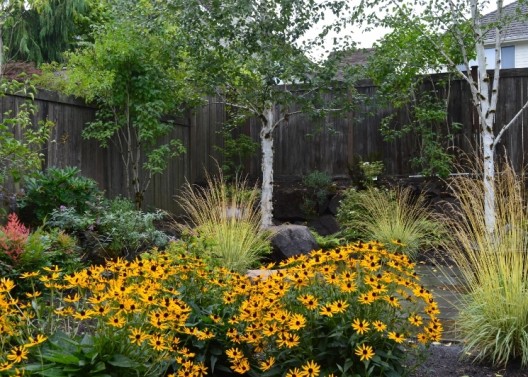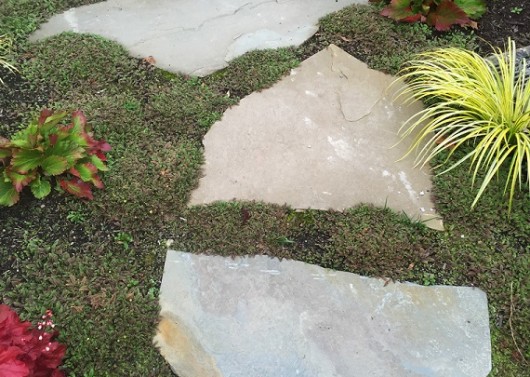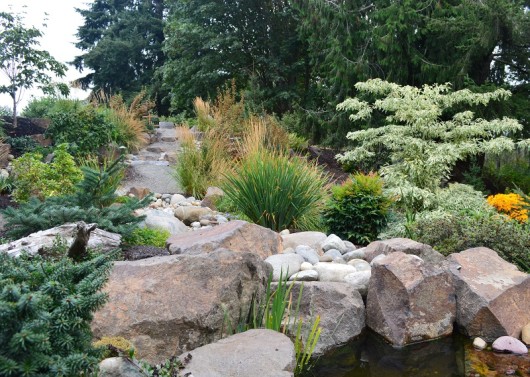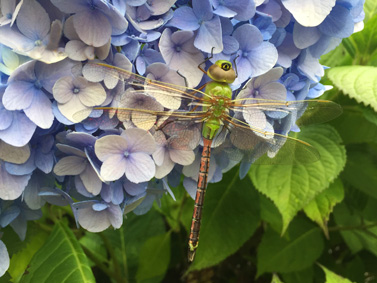How to create a more drought tolerant garden
Prepare now, or wilt later…
If you live and garden in the Pacific Northwest, like we do, you no doubt recall that last summer was one like no other that we can remember. And it’s true, May through July 2015 was the driest period on record and we had the hottest June and July on record with the most number of 80 and 90 degree days in one year. We averaged 2-4 degrees higher than normal. And thanks to El Nino, while this may not necessarily be the “new normal” as people are guessing, it is predicted that our warmer and drier weather will persist through this spring and summer, according to the Climate Protection Center www.climate.washington.edu.
The effects of drought on our landscapes can be devastating, ranging from plant casualties, to disease and pest infestations, to aesthetically unpleasing gardens and lawns. While many plants may be considered to be drought tolerant, they typically need a few years to become established before they can handle going for long period without water, and even longer to withstand the effects of a drought like we had this past summer.
If you have recently invested in your landscape this is the time to think about protecting your investment. Drought also puts stress on plants and makes them more susceptible to disease and insects. A healthy plant is more likely to resist disease and pests than one that is under stress. So, like human health, the best cure for disease is prevention.
Even if we don’t have a record breaking dry and hot summer like we did in 2015, the Pacific Northwest does typically experience some level of drought from July through August. And no matter where you live, conserving precious, life-giving water is always a good thing.
So what can you do now that will help your plants and your garden thrive when the rains come to an end?
Build Healthy Soil
Feed and protect your soil. Think of your soil like the foundation of your house. What is on top is only as good as what is supporting it. Most often if a plant, tree, or your lawn is suffering, it can be linked to the soil: too wet, too dry, lacking nutrients, etc. Without getting into the nitty gritty of soil biology, as a general rule you can usually improve your soil by adding compost to and/or mulching at least once per year.
Compost feeds the microorganisms in the soil. Think of the microorganisms as your own personal soil-building team that works for you non-stop…24/7. No holidays, no vacations. And all you have to do is feed them! Pretty sweet deal if you ask me. If you are preparing to plant a new area, working compost into the native soil will help to feed the soil and get your plants off to a great start.
To learn more about the importance of soil see Part 1 and Part 2 about soil heath. For more information about how to make your own compost click here.
Mycorrhizae Fungi
Mycorrhizae Fungi occurs naturally in the soils in our forests and undisturbed soils. These fungi have a symbiotic relationship with plants. The fungi attach to the roots of the plants and extend far beyond the typical root zone, which increases the plant’s ability to take up water and nutrients. The fungi get carbohydrates from the plant. Give and take…a beautiful partnership! It’s thought that about 95% of plants benefit from this relationship.
If you are starting from scratch and planting, for example, in a new construction home where the builder most likely scraped away all the good topsoil, inoculating your soil with Mycorrhizae Fungi when planting new plants can help to get your plants off to a great start and increase their resistance to drought.
For more information on Mycorrhizae check out www.mycorrhizae.com
Mulch
For existing planting areas, top-dress with 2-3” of a composted mulch or arborist chips at least once per year to provide insulation, moisture retention, temperature control, prevent erosion, and also act as a slow release source of nutrients for the plants by feeding the microorganisms in the soil.
Mulch is also great for weed control. By covering up the weeds seeds in the soil (and then minimizing the disturbance of soil as much as possible) they remain dormant and keep from germinating. The best time to mulch is late winter or early spring and fall. I like to do it before my herbaceous perennials, like Hostas, emerge. Avoid applying mulch when the soil is very dry in the summer.
Learn more about mulching and making your own here. (side note: don’t waste your money or time on landscape fabric as it causes more problems than it solves)
Check out www.chipdrop.in to find out how you can get free or low cost arborist chips delivered to your garden
An Organic Lawn is a Healthy Lawn
Lawns tend to get a pretty bad rap these days, but as we see it there is nothing wrong with having a lawn. Lawns are great for play areas for pets and children. That being said, maintaining your lawn organically is the safest and most sustainable way to go. The key to creating a sustainable lawn that is drought tolerant is…you guessed it: soil!
Unfortunately, many of us have inherited a lawn that was planted on about 1” of topsoil with hardpan underneath. Lawns like this have nowhere for their roots to go. They sit on the surface begging for water and nutrients in the driest parts of the year and sit waterlogged and deprived of oxygen in the rainy months.
It’s also important to note that chemical and synthetic fertilizers are detrimental to the soil life, so switching to organic fertilizers and mulch mowing are healthier for both the lawn and the people and pets using it.
When preparing a new lawn area, a minimum of 6”, but preferably 12” of topsoil, will give your lawn enough depth to create a healthy sustainable root system. To renovate an existing lawn, thatch and aerate, top-dress with ¼” of compost and then over-seed. This can be done annually and over time will help to your lawn to be more drought tolerant.
Setting your mower to cut at a height of 2 ½-3” helps the lawn to retain moisture and remain thick enough to outcompete the weed seeds. Leaving the clippings on the lawn is a natural source of nitrogen and saves you from having to dispose of them.
Water less frequently but more deeply. Watering deeply encourages deep root growth and over time and results in a more sustainable and drought tolerant lawn.
Let your lawn go gold. A healthy lawn with a deep root system is quite resilient. Watering your lawn 1” once per week may not keep it lush and green but it will be enough for it to remain alive and bounce back once the natural rains return.
If you’d like more information on how to create healthy and beautiful lawn, The Organic Lawn Care Manual is a great book on sustainable lawn care.
Right plant, Right Place
This might sound overly simple- plant plants where they will grow best (full sun, part sun, part shade, deep shade, wet, dry, and in an area that will allow them to grow to their mature size without being crowded). This is key to a sustainable garden and will make your life as a gardener a lot easier. Plants that are planted in the right place will more quickly become self-sustaining and require less input from you.
That means less water, fertilizer, and pruning to fit the space. You may also want to consider switching out plants with high water needs, like Hydrangeas, for less-thirsty types. Large boulder outcroppings also take up soil space, add structure to the garden, and are very drought tolerant…wink.
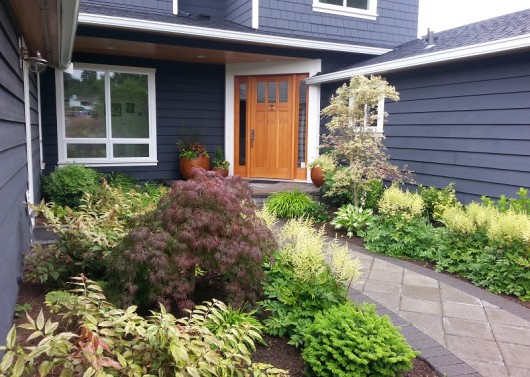
Select the right plants for the exposure and mature size. This client wanted a very lush planting and even though this garden is 2 years old there is still room for the plants to grow and fill in
Water smarter
When you water, how you water, and what you water all make a difference. Watering first thing in the morning is our preference. If you are watering by hand and you aren’t able to get out first thing in the morning late evening works too. It’s best not to overhead water, especially in the evening, so that water does not sit on the foliage all night and encourage fungal diseases.
If you are hand watering, using a watering wand helps to direct the water right where you need it- to the roots of the plants. Not up for hand watering? Consider adding or modifying your current system to drip irrigation. Drip irrigation delivers water efficiently, with the least evaporation. Drip irrigation is also better for weed control as it delivers water directly to the roots of the plants, unlike sprays which will provide water to weeds seeds on top of the soil. A rain sensor, which senses when it rains and turns off the system, can also cut your water usage by up to half.
Yes, watering does increase the cost of your water bill but is a cheaper than replacing plants, especially large trees and shrubs! Get more tips on watering.
Do you have other hints for creating a drought tolerant garden? Share them in the comments below!
Heidi
Organized under Garden Maintenance, Garden Tips & Advice, Low Maintenance Gardens, Sustainability. Labeled as Compost, Composting, Drought Tolerant, garden care, Gardening tips, low maintenance, low water use, Organic compost, sustainability.
